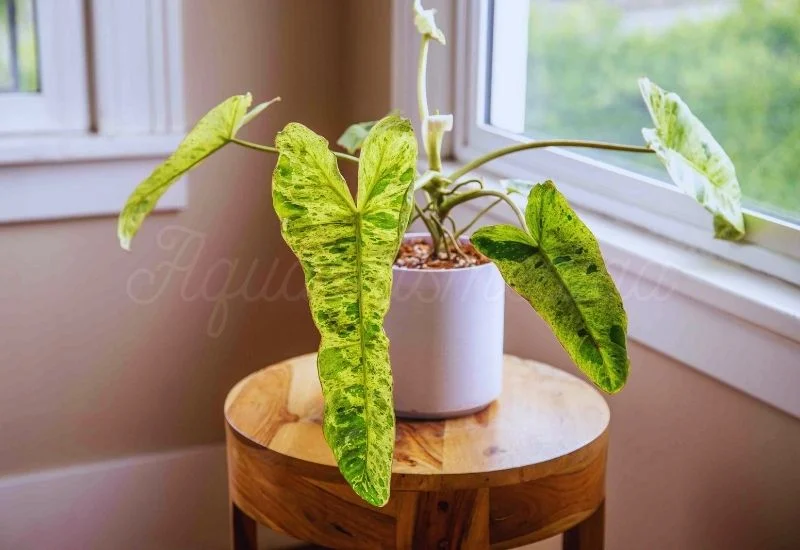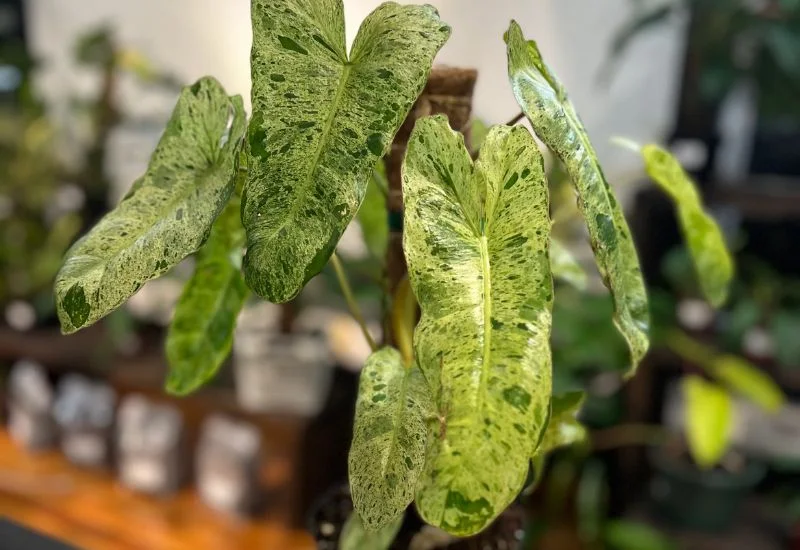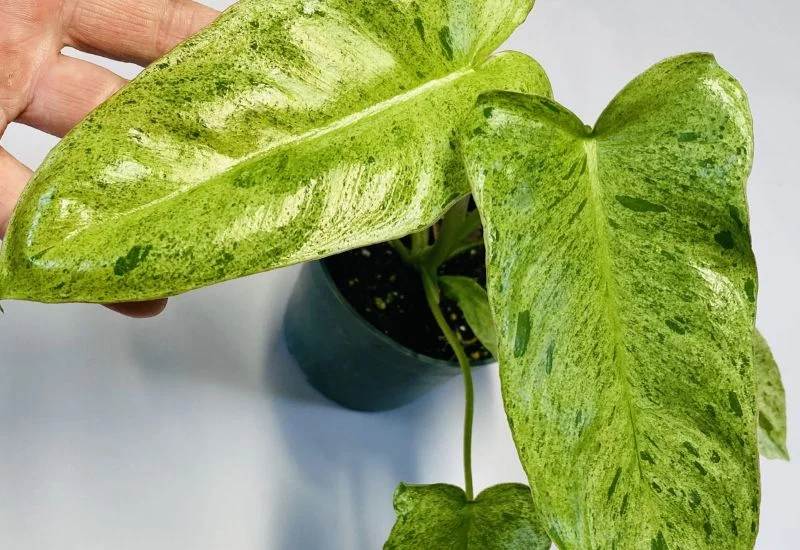In this blog post, you’re going to learn how to easily propagate and care for Philodendron Paraiso Verde.
This is a comprehensive guide covering reliable information about different aspects of this variety.
In this post, I’ll cover:
- Interesting Facts
- Propagation
- Repotting
- Care
And
- Solutions to Common Problems
So, if you are looking to propagate and care for Philodendron Paraiso Verde, this guide is for you.
Fun Facts
| Common Name | Philodendron Paraiso Verde |
| Botanical Name | Marina ruy barbosa, Paraiso verde |
| Family | Araceae |
| Plant Type | Vine or climbing nature |
| Fruit | Small berry-like (rare) |
| Mature Size | 10 ft. long, 2 ft. wide |
| Sun Exposure | Bright and indirect light |
| Soil Type | Moist and well drained |
| Soil pH | Acidic |
| Native Area | America and the West Indies |
| Toxic | Toxic to human and pets |
| Growth | Fast growing |
Philodendron paraiso verde is a beautiful plant characterized by vibrant greens and relatively low maintenance, hence its popular among plant lovers. Its appearance is similar to other types of Philodendrons, with a bi-tone or multicolor appearance, such as the Philodendron burle-marx and the Philodendron jose-buono. All these plants have one prominent feature in common, which is that the green and cream foliage of the plants have unpredictable designs. Moreover, It has elongated leaves, which appear to have moderate, calm patterns compared to the energetic contrasts of the other types..
The growth period of Philodendron paraiso verde is relatively fast, especially in ideal conditions. Like many philodendrons, it prefers a warm, humid environment with filtered light. The new leaves are formed more frequently during the spring and summer seasons, which are considered favorable for the growth of plants. It can be pruned to grow on the moss pole or any support structure. They needed support not only for vertical growth.
The most distinguishing feature of Philodendron paraiso verde is the impressive leaves. These are slender with pointed extremities and can grow to enormous sizes in favoring conditions. Its leaves have a light green and dark green coloration that is occasionally bordered by cream or yellow stripes. The texture of the leaf may be somewhat rough, but it may be almost sandpaper-like. A glossy finish is standard and adds to the appearance of the plant.
Flowers and Fruiting
The structure of the Philodendron paraiso verde’s flowers is not its major characteristic. It bears marks like spathe and spadix, which are typical for the members of the Araceae family, but flowers are hardly observed indoors.
The spathe is a leaf and it encircles the spadix which has the real flowers of the plant. The spathe is normally green or white and generally has the role of shielding the spadix where the reproductive structures are found.
Benefits

Philodendron paraiso verde has the following potential benefits;
Aesthetic Appeal
- It has an unusual marginated kind of leaves that are green with cream and yellow patches.
- Long, narrow leaves create an attractive structure for the plant.
- Improves interior design with a sense of tropical climate.
- It can be used to enhance many interior designs, from the contemporary to the bohemian.
Low Maintenance and Care
- The plant prefers bright indirect light but can also adapt to low-light conditions.
- A kind of plant that needs moderate water, often when the surface of the soil is dry.
- Flexible and highly sustainable for those who are just starting seed plant hobbyism as well as for those who have been into it for some time.
- Very little maintenance is required, so it is perfect for every home or office.
Air Purification
- Helps to eliminate indoor pollution, such as formaldehyde, benzene, and carbon monoxide.
- It enhances the indoor environment and moderates the air quality, creating a healthier indoor environment.
- Suitable for spaces that are located in large city areas where air freshness is likely to be an issue.
- It may improve objective health and limit common allergy manifestations.
Stress Reduction
- Affection towards plants and caring for them can reduce stress and promote relaxation.
- P. verde produces vibes of a sense of peace and mindfulness.
- It enhances emotional well-being and leads to stress reduction.
Uses

This plant is valued for its spectacular leaves, which is why it is especially liked by those who adore indoor plants. Here are some common uses:
Decorative Plant: The patterns on the leaves of the Philodendron Paraiso Verde are green, creamy, and light yellow which make it an outstanding ornamental plant.
Air Purification: Paraiso Verde is recognized for its ability to remove toxins from the air. It is used in the extraction of effluent air, eradicating such poisonous gases as formaldehyde, benzene, and carbon monoxide to make our indoor surroundings much healthier.
Gift Plant: Paraiso Verde Philodendron is also beautiful and relatively simple to care for. It is a gesture of warmth and could be taken as a housewarming, birthday, or holiday gift.
Collector’s Item: Due to the nature of the plants that thrive in the area, the Paraiso Verde has become a prized collection of plant collectors.
Propagation
Just like its care, the propagation of this plant is also not too much hectic. Here’s how you can do it:
Selection of the Stem: Select a green and mature stem on which there is a node, a small round structure from which leaves and roots grow. The node is rather important for the new growth.
Cutting: Remove the stem at the first node with a clean, sharp knife or a pair of scissors.
Rooting in Water: Take a glass of water and put the cutting in it, with the node under water but not touching the leaves. To maintain the water’s cleanliness, try to replace the water every 2 to 3 days. The cutting will begin sprouting within a few weeks, and roots should begin to grow.
Rooting in Soil: If rooting in water is not possible, you can simply place the cutting directly into the soil, where it will receive the right amount of moisture and nutrients. Make sure that the soil remains moist at all times, and place the pot under bright, filtered light and high humidity.
Repotting
Repotting is a crucial step in Philodendron Paraiso Verde care to keep it growing and healthy. Here’s how to do it:
When to Repot: Repot when the plant has grown out of the pot, when the roots protrude from the drainage holes, or when a dense mass formed inside the pot. Usually, repotting is carried out after one to two years.
Season: It is appropriate to report at the time of active growth, spring or early summer. This assists the plant in adapting to the new environment in the pot before the season of dormancy sets in.
Choosing the Right Pot Size: Choose a pot slightly larger than the current one; it should be 1-2 inches larger in diameter. Do not use large pots since they can hold a lot of water, and the plant’s roots may rot.
Material: To avoid flooding the pot with water, use a pot with drainage holes. If possible, terracotta pots are better since they permit air to reach the roots.
Soil Preparation: This is very important because the plant grows best in well-draining soil similar to the plant’s natural tropical environment. A good combination is three-quarters soil of the planting one, a quarter perlite, and half fine orchid bark.
Adding Organic Matter: You can also incorporate other organic materials, such as compost or worm castings, into the soil.
Repotting Process
Preparation: Water the plant in a last pot a day before repotting. This will make it easy to transplant the plant to the new pot.
Removing the Plant: Carefully remove the plant from the pot without causing much harm to its roots. If the plant is root-bound, gently try to comb the roots with your fingers.
Repotting: Transfer the plant into the new container containing freshly prepared soil mix. Fix the plant in the pot up to the same depth as in the previous plant. Spare some room at the top of the pot for watering.
Watering: It is recommended that water be given to the plant after the repotting process because this allows the soil to firm up on the roots. Make sure the excess water pours out.
Care

Proper care is required for the maintenance of the philodendron paraiso verde as well as its sustainability. It ensures your indoor green partner has been with you for years. The following are the major parameters that should be considered for your philodendron paraiso verde;
Pruning
With the passage of time, when the plant grows in size. Ultimately, at a specific level, the roots are out of the pot. It is the right time to cut down the extra roots of the plant. However, the leaves and stems should be maintained as usual for effective growth. The dead or non-growing parts should be removed immediately. This is because it is a burden on the plant and affects its normal growth.
Soil
For the healthy growth of the philodendron paraiso verde a moist, fertile but well-draining soil is required. The draining of the soil along with the presence of the nutrients is essential. It prevents the plant from rotting.
Pot
The size, material, and specific features are also required for the pot of the plant. The pots made from clay or terracotta are preferred because they are porous and cold to the plant roots. But, plastic-made pots can also be used if they are not sealed. The draining holes are essential in the plant pot irrespective of the material of the pot.
Water
Regular and maintained watering is required for the safe growth of the plant. Overwatering may lead to waterlogging and, ultimately, root rot and fungal growth. On the other hand, less watering results in the yellowing of the leaves and stunted growth.
Light
Most species of the Philodendron, like Philodendron paraiso verde, needed bright and indirect light. The humidity of 60-70% is best for optimum growth. Use the water tray or humidifier to meet this level if the air is dry.
Fertilizer
Fertilizers are essential to meet the nutrients and mineral requirements of the plants when the growth is at its peak. So, to provide a well diluted maintain fertilizing growth is at peak. On the other hand, the supply of fertilizers should be limited when the plant is in the dormant phase, especially in the fall or autumn.
Placement
Place the plant in a shady area or beside the window where a bright but indirect light reaches. These are the philodendrons’ favorite places.
Common Problems

Here are the few common problems with their solutions that the mostly paraiso verde philodendron owners face;
Pests
This species is very fragile and sensitive to most of the common pests, like aphids, mealybugs, and spiders. Check them regularly for a manifest of pests. If any type of growth or attack is seen, then apply the fungicidal spray before the situation becomes severe.
Fungal Diseases
Fungal disease can also attack this philodendron species. Waterlogging and dirt are the two major reasons for the fungal attacks. This is because the damp and dirty places are the favorite ones for the fungus to live in.
So, by regular cleaning and proper washing, you may keep your plant safe from this curse.
Brown Tips
Bron tips are one of the major problems that most novice gardeners suffer from. It is due to poor management of the light or diet of the plant. The lack of the proper light or minerals leads to the browning of the tips in plants.
This can be reverted easily back to normal growth at the initial stage by ensuring the right light conditions and fertilizing.
Curling Leaves
The leaves of the philodendron paraiso verde may lead to curling due to the underwatering or low humidity. If you notice the leaves are curling then maintain the watering of the plant. Also, check for the humidity level. Use the humidifier or place the water tray near the plant.
Yellow leaves
Mostly, direct sunlight exposure or high temperatures lead to yellowish leaves in the plants. So, if leaves start yellowing then change the place of the plant in a bright indirect light and temperature range 18-27°C.
Yellow leaves may also appear due to the poor fertilizing schedule. So, try to maintain proper fertilization.
Varieties & Similar Plants
Philodendron Paraiso Verde is one of the most popular types of Philodendron among collectors and those who love ornamental foliage plants with non-symmetrical patterns on the leaves that have diverse shades of green. The foliage can turn yellowish or get creamy patches, which are quite beneficial to the plant.
Varieties
Though the Paraiso Verde itself is recognized as a separate variety under the philodendron genus, there are no authenticated sub-varieties or cultivars of this particular plant.
But here is a list of plants that are highly similar to this cultivar;
Similar Plants
Philodendron Brasil: This variety has large heart-shaped leaves with yellow-green contrasting mottling on the surface. It is appreciated by persons with an outstanding aesthetic sense. However, the pattern of variegation is anyway more structured and not as marbled as in the case of Paraiso Verde.
Philodendron Lemon Lime: One of the most easily identifiable by the color of its leaves is this variety, which has a significantly lighter green color than its neighbors and can be easily confused with some of the Paraiso Verde. It has a somewhat lighter shade of green but has the same thing as large lance-shaped leaves that are elongated.
Philodendron Florida Ghost: This is yet another sought-after plant because of its new white or pale green foliage that turns blackish as it ages. Even though the form is different its changing scaly plate color reminds us of the variegation of the Paraiso Verde.
Monstera Deliciosa Variegata: Even though it is not a philodendron, the Monstera Deliciosa Variegata is somewhat similar to the Paraiso Verde owing to its large, variegated leaves. The variegation patterns may look similar, but the differences include the structure of the leaves and their manner of growth.